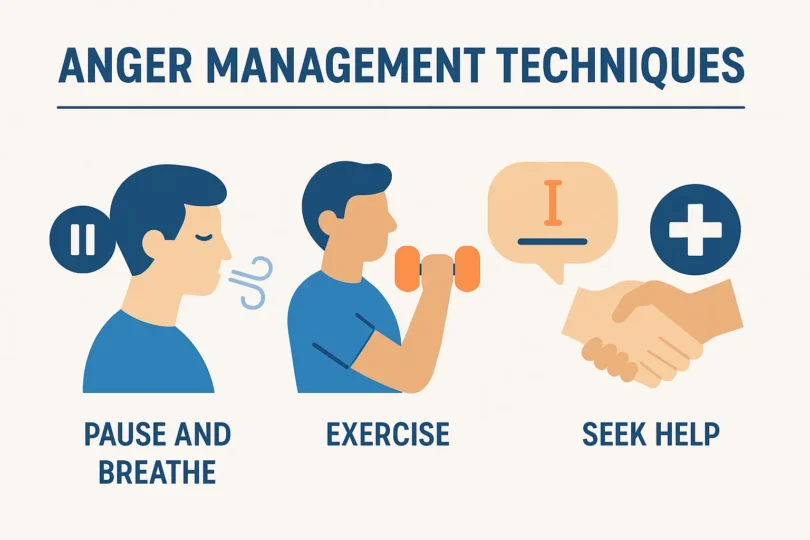Anger is a normal emotion — but when it turns explosive, it can damage your relationships, your work life, and your own peace of mind. If you’ve ever felt like your temper is calling the shots, you’re not alone. Many adults struggle with controlling their anger, especially when stress, frustration, or emotional triggers pile up.
The good news? You don’t have to stay stuck in a cycle of outbursts and regret. There are proven anger management techniques for adults that can help you cool down before things heat up — and respond instead of react. In this guide, we’ll break down the tools, insights, and support systems that can help you stop rage in its tracks and take back control of your emotions — one smart step at a time.
Headlines
10 Powerful Anger Management Techniques That Actually Work
Healthy Expression and Long-Term Coping Strategies
Understanding Adult Anger
Anger doesn’t just come out of nowhere. For most adults, it’s a slow burn caused by a mix of daily stressors, emotional baggage, and mental fatigue. To effectively use anger management techniques for adults, it’s important to understand where this emotion stems from and what’s going on behind the scenes — mentally, emotionally, and even neurologically.
🔥Common Triggers and Emotional Patterns
Adult life comes with a cocktail of responsibilities, deadlines, and unspoken expectations. Add unresolved past experiences or a tendency to bottle things up, and it’s a perfect storm for anger to erupt.
Some of the most common anger triggers in adults include:
- Work-related stress: Unrealistic demands, poor communication, and toxic work environments
- Relationship tensions: Misunderstandings, lack of emotional support, or repeated patterns from childhood
- Financial pressure: Debt, unexpected expenses, or the pressure to provide
What often makes anger in adults harder to manage is emotional buildup. We tend to push down our frustration until it finally explodes — usually at the wrong time or toward the wrong person. This is where emotional intelligence plays a crucial role. Being aware of your feelings as they arise, naming them without judgment, and choosing how to respond instead of reacting impulsively — that’s the foundation of healthy anger management.
🧬 What Happens in the Brain When You’re Angry
When you feel angry, it’s not just emotional — it’s biological. Your brain instantly shifts into defense mode.
The amygdala, the brain’s emotional alarm system, picks up on a threat — whether it’s real or just perceived. This triggers a fight-or-flight response, flooding your system with adrenaline and cortisol. Your heart rate increases, muscles tense, and breathing quickens — your body is gearing up for action.
But here’s the catch: while your amygdala is sounding the alarm, your frontal lobe — the part of your brain responsible for logic, reasoning, and impulse control — gets overridden. This is why people say things they regret or lash out without thinking. The ability to pause, think, and choose a better response gets hijacked in that angry moment.
Understanding this brain-body dynamic is essential. It helps you realize that managing anger isn’t about suppressing it — it’s about regulating your stress response and training your brain to respond, not react. That’s the core of effective anger management techniques for adults.
10 Powerful Anger Management Techniques That Actually Work
When anger takes the wheel, it’s easy to feel out of control — but you can take the power back. These anger management techniques for adults aren’t just tips you read and forget. They’re real-world tools that help you process, release, and respond to anger in healthier, more productive ways.
Here’s what actually works:
1. Pause Before You React
That split second between feeling angry and acting on it? That’s your power zone. Train yourself to take a beat — literally count to 10 or take a deep breath. This pause activates your frontal lobe, helping you respond with logic instead of rage.
2. Practice Deep Breathing
When you’re angry, your body goes into fight-or-flight. Slow, intentional deep breathing resets your nervous system. Try the 4-7-8 method: inhale for 4 seconds, hold for 7, exhale for 8.
3. Use Physical Movement to Release Energy
Anger is energy. Get it out — but in a way that won’t cause damage. Go for a brisk walk, hit a punching bag, do some jumping jacks. Physical activity helps burn off the surge of adrenaline and lowers cortisol levels.
4. Name What You’re Feeling
Sounds simple, but it’s powerful. Saying “I’m feeling overwhelmed” or “I’m disappointed” brings awareness to the emotion beneath the anger. That awareness is a key part of emotional intelligence, helping you process instead of explode.
5. Challenge Negative Thoughts
Many angry outbursts are triggered by distorted thinking. “They always do this,” or “No one cares about me.” This is where Cognitive Behavioral Therapy (CBT) shines — it teaches you to spot irrational thoughts and reframe them.
6. Remove Yourself from the Situation
Sometimes the best thing you can do is step away. Excuse yourself, go to the bathroom, or take a walk. Distance gives you perspective and can break the cycle before things escalate.
7. Communicate with Clarity, Not Volume
Anger doesn’t need to be loud to be heard. Use “I” statements to express how you feel without blaming: “I feel disrespected when I’m interrupted” instead of “You never listen!”
8. Try Progressive Muscle Relaxation
Tension lives in your body. Progressive muscle relaxation involves tensing and relaxing different muscle groups to let go of stored anger. It’s a great way to physically calm down.
9. Keep an Anger Journal
When you write down what triggered you, how you responded, and how you could handle it better next time, you start noticing patterns. Journaling builds self-awareness and gives you space to reflect.
10. Talk to a Professional
If your anger feels too big to manage alone, there’s no shame in getting help. A therapist can guide you through deeper emotional healing, provide tailored anger management techniques, and help you regain control.
Anger Management Techniques, No single strategy works overnight, but building these habits over time can reshape how you deal with anger for good. Start with one technique that resonates, practice it daily, and watch your emotional resilience grow.
Healthy Expression and Long-Term Coping Strategies
Healthy expression and long-term coping strategies are essential tools for managing life’s challenges in a balanced and resilient way. When we learn to express our emotions constructively, we can release pent-up stress and promote emotional well-being. Alongside this, developing long-term coping strategies allows us to navigate future difficulties with more ease and confidence. In this section, we’ll explore how these two aspects work together to enhance emotional health, strengthen resilience, and lead to lasting peace of mind.
Communicating Anger Constructively
Let’s face it — anger is a normal human emotion. The problem isn’t feeling angry. It’s what you do with that anger. Many adults struggle not because they’re too emotional, but because they were never taught how to communicate anger constructively.
That’s where emotional intelligence and healthy communication skills come into play — two powerful ingredients in effective anger management techniques for adults.
❌ What Doesn’t Work
- Yelling to be heard
- Giving the silent treatment
- Sarcasm or passive-aggressive comments
- Bottling things up until they explode
These behaviors might release some pressure in the moment, but they usually damage relationships and leave things unresolved. Worse, they often create guilt, shame, or regret afterward — which just fuels more anger.
✅ What Does Work
1. Use “I” Statements
Instead of pointing fingers with “You always…” or “You never…,” shift the focus to how you feel. This reduces defensiveness and keeps the conversation calm.
- Try this:
“I feel hurt when I’m interrupted while speaking because it makes me feel unheard.”
This approach is simple but powerful — it’s honest without being aggressive.
2. Express Anger Without Blame
You can be upset and still show respect. The key is to talk about your needs and boundaries without attacking the other person’s character. Use assertive — not aggressive — language.
- Aggressive: “You don’t care about me!”
- Constructive: “I need more support when things get stressful at home.”
3. Time Your Conversation Wisely
Don’t try to have a serious talk when you’re still boiling. Let your body cool down before opening up. Communicating in a calm state improves clarity, listening, and resolution.
4. Practice Active Listening
When it’s your turn to listen, really listen. That means not interrupting, not preparing your next comeback, but actually hearing what the other person is saying. Reflect back what you heard to make sure you understand.
- “So what I’m hearing is that you felt dismissed during the meeting?”
Active listening de-escalates tension and builds mutual respect — essential for long-term conflict resolution.
How Active Listening Can Resolve Conflicts in Your Relationship
5. Set Boundaries With Confidence
Anger often signals that a boundary has been crossed. Learn to state your limits with calm assertiveness. Whether it’s saying no to toxic behavior or asking for space, this is one of the most empowering anger management techniques for adults.
💡 Final Thought:
You don’t have to suppress your anger — you just have to express it better. Learning to communicate anger constructively doesn’t just reduce conflict. It also strengthens your relationships, protects your mental health, and builds long-term emotional resilience.
Seeking Professional and Ongoing Support
Sometimes, anger isn’t just about that one bad day or a single frustrating event. It can be deep-rooted, chronic, or tied to past trauma, mental health challenges, or unresolved emotional wounds. When anger starts to interfere with your relationships, work life, or overall well-being, it’s time to consider professional and ongoing support.
This isn’t a sign of weakness — it’s actually one of the smartest and strongest steps an adult can take. And in many cases, it’s where real transformation begins.
👥 Why Therapy Makes a Difference
A licensed therapist — especially one trained in anger management, cognitive behavioral therapy (CBT), or emotional regulation techniques — can help you dig below the surface. You’ll work together to:
- Identify the root causes of your anger (not just manage the symptoms)
- Understand your triggers and how they’ve developed over time
- Develop coping tools that are tailored to your personality and lifestyle
- Reframe toxic thought patterns that keep feeding the cycle of frustration
Unlike generic advice, therapy gives you a personalized roadmap and ongoing guidance as you make meaningful changes.
🤝 Other Support Options to Consider
Therapy isn’t the only route — though it’s often the most effective. Here are some ongoing support systems that can complement your journey:
- Anger management groups or classes: These structured programs offer education, support, and a community of people facing similar struggles.
- Support groups (online or in person): Safe spaces to share your experiences, release shame, and learn from others.
- Coaching or counseling services: These are less clinical than therapy but still offer goal-setting and skill-building support.
- Mindfulness centers or meditation teachers: Especially useful if your anger stems from stress or emotional overload.
- Books, podcasts, or courses: Self-help content from mental health experts can provide ongoing reinforcement and perspective.
🚨 When It’s Time to Seek Help
Ask yourself:
- Do I frequently regret how I handled a situation?
- Is my anger damaging my relationships or work performance?
- Do I feel out of control when I get upset?
- Have loved ones expressed concern about how I deal with anger?
If you answered yes to any of these, seeking professional help is not only wise — it might be essential. It’s not about being “broken.” It’s about being ready to grow.
💬 Final Thought:
There’s no shame in needing support — only strength in seeking it. Whether it’s a therapist, a group, or a guide you trust, the right help can turn anger from a destructive force into a source of personal power, healing, and emotional freedom.
You’re not weak because you feel anger — you’re human. But how you handle that anger? That’s where strength, awareness, and growth come into play. By practicing these anger management techniques for adults, you’re not just learning how to calm down — you’re learning how to communicate better, reduce stress, and protect your emotional well-being.
Whether you start with deep breathing, journaling, or seeking professional support, the key is consistency. Small changes lead to big breakthroughs. So the next time anger flares up, remember — you have the tools to rise above it. And every time you choose control over chaos, you’re taking one more step toward a calmer, more empowered version of yourself.








Leave a Comment